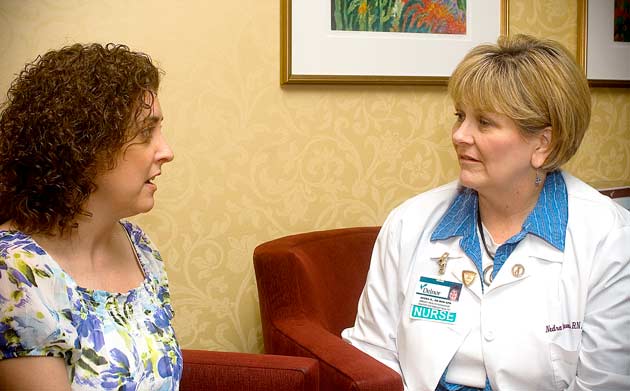Simple events to promote health and wellness among women are just part of the new programs and procedures that can help women stay healthy and happy. Learn what suburban-area health networks are leading the way.

Attention to women’s health concerns has steadily increased over the past few decades. Among other things, better-funded research has led to major advances in diagnosis, treatment and cures. Also, the health care focus has broadened, from merely treating disease to meeting the needs of the whole woman.
But one of the most powerful health care tools can’t be measured: awareness and open discussion among women about the conditions they encounter.
Because of their reproductive role, women are vulnerable to a unique set of diseases, with breast cancer at the forefront. While a small percentage of men are diagnosed with breast cancer, it remains predominately a woman’s disease. As a breast nurse navigator at Delnor Hospital in Geneva, Nedra Reeves, RN, knows what it takes to help breast cancer patients face their fears and deal with the confusion that comes immediately after receiving a cancer diagnosis.
“Think of me as the point person,” Reeves says. “I’m the person they can call with any kind of questions they may have about breast cancer, both physically and emotionally. I can assist them with getting appointments and be a listening ear. I can provide each woman with educational materials so she feels empowered as she meets with various members of her health care team.”
Along with surgical procedures and medical treatments, patients need help when it comes to issues like knowing how to talk with their children about cancer. Reeves facilitates a support group at LivingWell Cancer Resource Center, a Delnor Health System affiliate that supports patients in just this way. LivingWell offers support programs to cancer patients and their families, including exercise, yoga, cooking and nutrition, massage therapy and counseling.
“LivingWell encourages patients to view themselves as survivors from the moment of their diagnosis,” Reeves says. “We have made such huge strides in cancer treatment that it’s now thought of more as a chronic illness that, with monitoring, cannot only be survived but lived with for many, many years.”
Jennifer Burke, a breast cancer survivor and Delnor patient, believes it is crucial to have someone with a good pair of ears and an understanding of what breast cancer patients go through.
“Patients need someone who can guide them through the diagnosis and all that medical terminology,” Burke says. “They also need a support system of friends and family who are there for them, accompany them to appointments, talk honestly and even bring them meals through the rough times.”
Burke was diagnosed with breast cancer in late summer 2009. Married with two sons, it was hard for her family to deal with her being out of commission for long periods of time.
“I had two surgeries about two weeks apart that August,” she says. “I was frantic. School was about to start and I hadn’t even bought the boys’ supplies yet. I really had to scramble.” Along with Reeves, family members and friends, Burke’s church family helped her tremendously.
“Our church provided us with a great deal of support through prayer, and there’s also a group within the church called Caring Community,” Burke says. “They brought us meals every day for nearly two weeks and kept us in their prayers.”

As a breast cancer survivor, Burke has a mammogram and ultrasound every six months, at the Delnor Center for Breast Health, plus an annual MRI, along with radiation and oncology follow-ups. She’s also being treated for a post-surgery condition.
“During surgery, nine lymph nodes were removed, which impedes the flow of lymph fluid,” says Burke. “Called lymphedema, this condition causes my arm and hand to swell painfully. Compression wraps and therapeutic massage can help to alleviate lymphedema, which occurs in a small percentage of patients who have had the surgery.”
Cervical cancer is another major concern that health-savvy women are mindful of. But Dr. Kelly Simkins, DO, OB/GYN, says its incidence has decreased more than 50 percent over the past 30 years. In her offices in Barrington and Crystal Lake, as well as through her practice at Advocate Good Shepherd Hospital in Barrington, Simkins sees patients who are conscientious about regular check-ups and immediate treatments.
“There are no obvious symptoms of cervical cancer,” she explains. “I see patients day in and day out who are at risk of having human papillomavirus (HPV), and that’s why PAP smears are so important.” Cervical cancer can be connected to HPV. While there are hundreds of types of HPV, about 75 percent of cervical cancer cases are caused by HPV Nos. 16 and 18.
“We used to advise women to begin regular PAP smears at age 18, or when they become sexually active, but now we recommend they have the test every year or two starting at age 21, following the American College of OB/GYN guidelines,” Simkins says. “After age 30, the testing of HPV with the PAP can be implemented. PAP smears should be continued until between 60 and 70 years old. The minimum age changed because HPV is frequently found in the adolescent population, but can be transient due to a strong immune system. We are more concerned about HPV, cervical abnormalities and cervical cancers after a women passes her 21st birthday.”
When a PAP smear biopsy reveals an abnormality, the patient may be sent back to her physician for a colposcopy. This procedure is usually done in the physician’s office.
“When we find significant evidence of HPV during the colposcopy, the next step is called LEEP [loop electrosurgical procedure],” says Simkins. “The patient is treated to numb the cervix. A solution is used to locate the HPV, and the affected cells are removed, which decreases the progression of the virus. Afterward, we monitor the patient through six-month PAP smears.”
Left undiscovered and untreated over many years, the presence of HPV within the cervix can eventually lead to cancer. While cervical cancer is always a traumatic diagnosis, it is less common than it once was.
“For one thing, it’s being caught much earlier,” Simkins explains. “Women today are more aware of their unique health needs and are more inclined to have regular PAP smear tests. The introduction of Gardasil as a preventative measure in young women is where the future lies. The immunization targets two of the most common high-risk HPV viruses, and thus is a huge step in prevention.”
This is good news for women concerned about cervical cancer, Simkins says, but patients come to her with many other reproductive system problems that can be troubling as well.
“I see many cases of abnormal uterine bleeding on a day-to-day basis,” she says. “This can be caused by hormone imbalance, perimenopausal changes, fibroids, contraceptive side effects and numerous other conditions.”
Blood tests, ultrasounds and cultures help to determine the cause. In most cases, the condition can be addressed with hormone treatments, medications for infections, outpatient surgery, or major surgery.
Another health concern faced by women of all ages is uterine fibroids, small benign fibrous tumors that occurs on the muscle walls of the uterus. As an interventional radiologist, Dr. Tami Carrillo sees patients daily, at Provena Saint Joseph Hospital in Elgin, whose symptoms point to this sometimes debilitating condition.
“Uterine fibroids are made up of cells that lack the normal growth regulation mechanisms of normal cells, but are rarely malignant,” Carrillo says. “We really don’t understand why they occur, but they grow into round masses of smooth muscle and fibrous tissue. Most are between one and two centimeters, but some will continue to grow. By the time they grow to four or five centimeters, the patient knows something is wrong. I’ve seen them as large as 11 centimeters, which can make a woman look pregnant when she’s not.”

“Once uterine fibroids are diagnosed, the physician discusses treatment options,” Carrillo says. “Oral or injected hormone therapy to shrink the fibroids can be tried, but the effectiveness is variable. Additional options are myomectomy, hysterectomy or, the most recent advancement in treating uterine fibroids, embolization.”
Myomectomy is a minimally-invasive surgical procedure in which a video camera is inserted through tiny incisions to locate the fibroids, which the surgeon then removes laparoscopically. Unfortunately, if the fibroids are difficult to reach, the surgery may end in a traditional hysterectomy.
“Embolization is a great alternative,” Carrillo says. “Using minimally-invasive techniques, we enter the uterine arteries with a catheter and inject tiny particles, which travel downstream and lodge in the capillaries that bring the blood supply to the fibroids. This shuts off the flow of fresh blood and, over time, the fibroids will die.”
While patients may fear that this procedure might also close down vital blood flow to the rest of the uterus, Carrillo emphasizes that the uterus has no problem developing new blood supply routes. She adds that the only downside to embolization is the initial pain that patients experience while fibroids are dying, along with the possibility of nausea and light spotting. If I had to make a choice, I would choose embolization first,” she concludes.
Given the unique health issues women face, it’s vital to make them aware of how to recognize and even prevent them. This April, Provena Saint Joseph Hospital’s Women’s Services presented “LOL: Laugh Out Loud and Love Our Lives,” a day-long event that focused on heart health and hormone therapy; non-surgical and minimally-invasive procedures; overall breast health; and stress relief.
“While there are some things about getting older that we can find humor in, there are some other age-related issues that should be taken seriously,” says Heather Gates, Provena’s regional director of marketing and public relations. “You may think you have to put up with them, but you don’t.”
Technical advances, awareness campaigns, outreach educational programs, networking and resource development are all tools for encouraging women to be proactive about their personal health. But a little incentive doesn’t hurt, either.

“Women often overlook taking care of their own health and wellness, when they’re so busy taking care of others,” says Susan Milford, Centegra’s vice president of marketing, planning and wellness. “The add-a-pearl program is a way to empower and encourage women to make their health a priority.”
Women can register for the program at centegra.org/pearl. Then, at the conclusion of the appointment or class, they’ll receive a drawstring bag containing the pearl and instructions on how to get it strung onto a micro-cord necklace for $5 at Dalzell Jewelers.
“Women are the caregivers of their families, the foundation of our region’s businesses, and the role models for children in our community,” says Jenny Dalzell, vice president of Dalzell Jewelers. “We encourage them to put their own health care first, and to enjoy the rewards of this exciting promotion.”
Because of the powerful commitment to women’s services by healthcare systems throughout the Chicago suburbs, women of all ages can look forward not only to enjoying a healthier and longer life, but also to acting as role models for their daughters, and encouraging them to take control of their futures by taking care of themselves. In turn, this helps to ensure a better tomorrow for women and their loved ones. ❚





















































